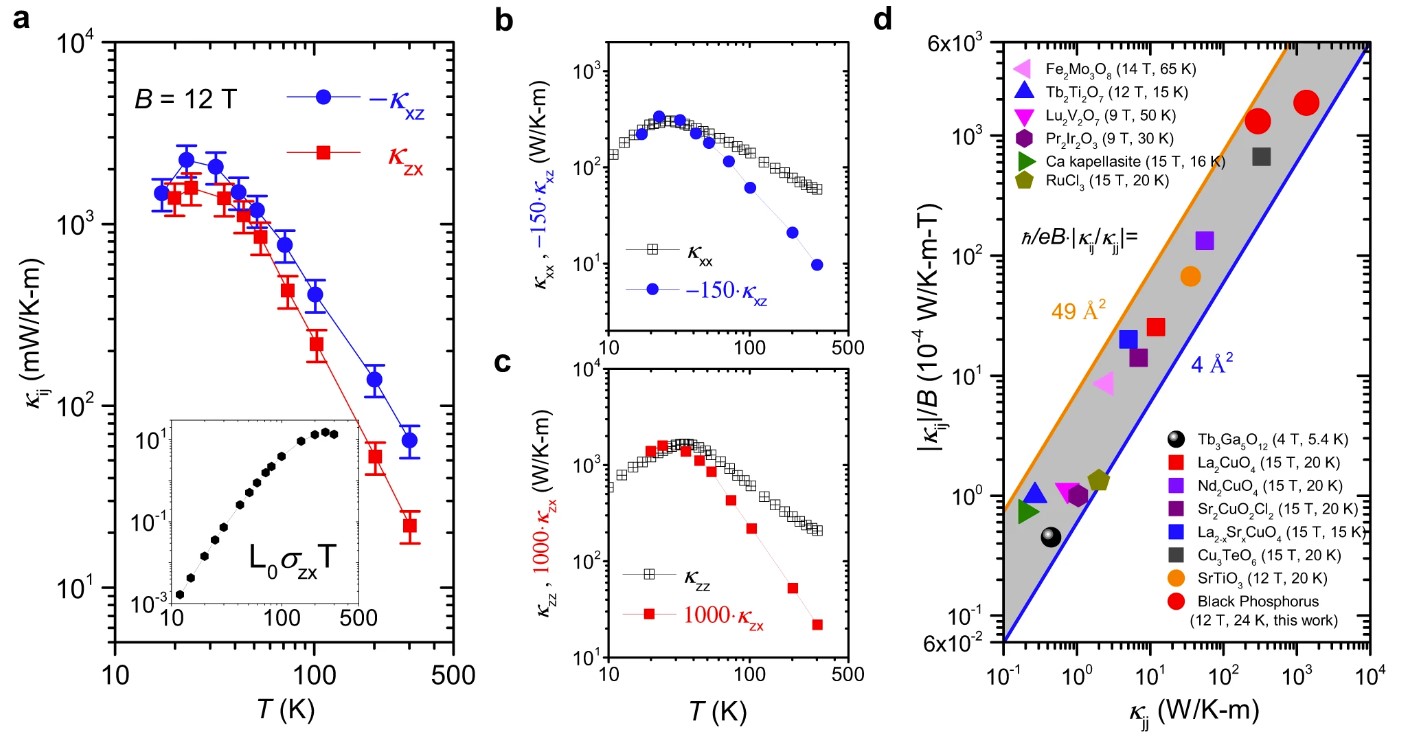
Fig.1: (a) Temperature dependence of the measured off-diagonal thermal conductivities, κzx and −κxz. At low temperature, they become equal to each other within experimental margin, as expected by Onsager reciprocity. With warming towards room temperature a difference arises, presumably due to non-negligible contribution of the thermoelectric response to transverse heat flow. (b-c) Comparison of the temperature dependence of longitudinal and transverse thermal conductivities. Note that they all peak almost at the same temperature. (d) Comparison of the transverse κij/B and the longitudinal κjj thermal conductivity in different insulators. Even though the longitudinal thermal conductivity κjj varies by 4 orders of magnitude, their ratio κij/κjj/B remains within the range of ≈ 10−4–10−3 T−1.
Background
Thermal Hall effect (THE) refers to the emergence of a transverse thermal current by a longitudinal thermal gradient, in presence of a magnetic field. In metals, it is intimately linked to the electrical Hall effect through the Wiedemann-Franz law. Following its original discovery, thermal Hall effect was observed in a wide variety of insulating solids . Its origin is controversial in exotic cases, but in strontium titanate, a non-magnetic insulator, THE is undoubtedly caused by phonons and is drastically reduced by the introduction of extrinsic atoms. These observations motivated numerous theoretical proposals for a thermal Hall signal produced by heat-carrying phonons. They can be broadly classified as either intrinsic (invoking the peculiarities of the phonon spectrum) or extrinsic (referring to consequences of specific phonon scattering mechanisms).
What we discover?
What are the minimal ingredients required to produce a detectable THE? To what extent the effect seen in various families share a common origin? Here, we address these two questions by reporting on the observation of thermal Hall effect in black phosphorus (BP), the simplest insulator known to display THE. It is not only non-magnetic, but also lacking ionic bonds. Interestingly, while the amplitude of the thermal Hall conductivity in BP exceeds what was found in all other insulators, the transverse and the longitudinal thermal conductivities peak at the same temperature and their ratio has a similar amplitude. We note that the charge distribution is anisotropic and atomic vibrations can therefore respond to the magnetic field. We show that two out of the three acoustic branches anti-cross and are close to degeneracy in the momentum space, and therefore, energy transfer across harmonic vibrational states plays a role in setting the amplitude of thermal conductivity and since the charge distribution is anisotropic, magnetic field can couple to atomic vibrations. The austere context of our experimental observation strongly constrains theoretical scenarios.
Why is this important?
The paper first reports the phonon thermal Hall effect in an elemental insulator that hosts the largest thermal Hall conductivity in any reported insulating solids. Moreover, this paper summarizes two universal features of phonon THE: i) In all insulators displaying a thermal Hall effect, longitudinal and transverse thermal conductivities peak at the same temperature. ii) In all of them, the Hall angle does not depend on the magnitude of the thermal conductivity, despite the latter changing by more than three orders of magnitude.
Who did the research?
Xiaokang Li1,*, Yo Machida2, Alaska Subedi3,4, Zengwei Zhu1,* , Liang Li1 and Kamran Behnia5,*
(1) Wuhan National High Magnetic Field Center and School of Physics, Huazhong University of Science and Technology, Wuhan 430074, China
(2) Department of Physics, Gakushuin University, Tokyo, 171-8588, Japan
(3) Centre de Physique Théorique, École Polytechnique, CNRS, Université Paris-Saclay, Palaiseau, France
(4) Collège de France, Paris, France
(5) Laboratoire de Physique et d’Etude de Matériaux (CNRS-Sorbonne Université)
ESPCI, PSL Research University, 75005 Paris, France
Link
https://www.nature.com/articles/s41467-023-36750-3
Funding
This work was supported by The National Key Research and Development Program of China (Grant No.2022YFA1403503), the National Science Foundation of China (Grant No. 12004123, 51861135104 and 11574097 ) and the Fundamental Research Funds for the Central Universities (Grant no. 2019kfyXMBZ071). Y. M. acknowledges funding from Grants-in-Aid for Scientific Research (Grant No. 19H01840). A. S. acknowledges computational resources provided by GENCI-TGCC (grant A0130913028). K. B. was supported by the Agence Nationale de la Recherche (ANR-19-CE30-0014-04). X. L. acknowledges the China National Postdoctoral Program for Innovative Talents (Grant No.BX20200143) and the China Postdoctoral Science Foundation (Grant No.2020M682386).
